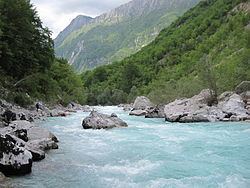Length 138 km | Basin size 3,400 km (1,300 sq mi) Discharge 172 m³/s Mouth Adriatic Sea | |
 | ||
Similar Julian Alps, Triglav National Park, Vršič Pass, Karst Plateau, Triglav | ||
I feel so a valley slovenia dji phantom 3
The Soča ([ˈsoːtʃa] in Slovene) or Isonzo ([iˈzontso] in Italian) (other names Friulian: Lusinç, German: Sontig, Latin: Aesontius or Isontius) is a 138-kilometre (86 mi) long river that flows through western Slovenia (96 kilometres or 60 miles) and northeastern Italy (43 kilometres or 27 miles).
Contents
- I feel so a valley slovenia dji phantom 3
- Map of Isonzo
- Slovenia julian alps and so a river valley
- Name
- Major changes in the watershed
- Attractions
- Significance in World War I
- References
Map of Isonzo
An Alpine river in character, its source lies in the Trenta Valley in the Julian Alps in northwestern Slovenia, at an elevation of 876 metres (2,874 ft). The river runs past the towns of Bovec, Kobarid, Tolmin, Kanal ob Soči, Nova Gorica (where it is crossed by the Solkan Bridge), and Gorizia, entering the Adriatic Sea close to the town of Monfalcone. It has a nival-pluvial regime in its upper course and pluvial-nival in its lower course.
Prior to the First World War, the river formed part of the border between Kingdom of Italy and the Austro-Hungarian Empire. During World War I, it was the scene of bitter fighting between the two countries, culminating in the Battle of Caporetto in 1917.
Slovenia julian alps and so a river valley
Name
The river was recorded in antiquity as Aesontius, Sontius, and Isontius. Later attestations include super Sontium (in 507–11), a flumine Isontio (1028), in Lisonçum (1261), an die Ysnicz (1401), and an der Snicz (ca. 1440). The Slovene name Soča is derived from the form *Sǫťa, which was borrowed from Latin (and Romance) Sontius. In turn, this is probably based on the substrate name *Aisontia, presumably derived from the PIE root *Hei̯s- 'swift, rushing', referring to a quickly moving river. Another possible origin is the pre-Romance root *ai̯s- 'water, river'.
Major changes in the watershed
The present course of the river is the result of several dramatic changes that occurred during the past 2,000 years. According to the Roman historian Strabo, the river named Aesontius, which in Roman times flowed past Aquileia to the Adriatic Sea, was essentially the Natisone and Torre river system.
In 585, a landslide cut off the upper part of the Natisone riverbed, causing its avulsion and subsequent stream capture by the Bontius River. The original subterranean discharge of the Bontius into the Timavo became obstructed, and another avulsion returned the new watercourse into the bed of the lower Natisone.
During the next centuries the estuary of this new river—the Soča—moved eastward until it captured the short coastal river Sdobba, through which the Soča now discharges into the Adriatic Sea. The former estuary (of the Aesontius, and the early Soča/Isonzo) in the newly formed lagoon of Grado became an independent coastal rivulet.
Attractions
Due to its emerald-green water, the river is marketed as "The Emerald Beauty." It is said to be one of the rare rivers in the world that retain such a colour throughout their length. Giuseppe Ungaretti, one of the greatest Italian poets, describes the Isonzo in the poem "The Rivers."
The Soča inspired the poet Simon Gregorčič to write his best-known poem Soči (To the Soča), one of the masterpieces of Slovene poetry. This region served as a location for the 2008 Disney film Chronicles of Narnia: Prince Caspian.
The Soča is also well known for its unique trout species Salmo marmoratus (known as the marble trout), which lives in the upper course of the crystal-clear river. This species is endangered due to the introduction of other non-indigenous trout species sometime between World War I and World War II.
Significance in World War I
The valley was the stage of major military operations including the twelve battles of the Isonzo on the Italian front in World War I between May 1915 and November 1917, in which over 300,000 Austro-Hungarian and Italian soldiers lost their lives.
The Isonzo campaign comprised the following battles:
